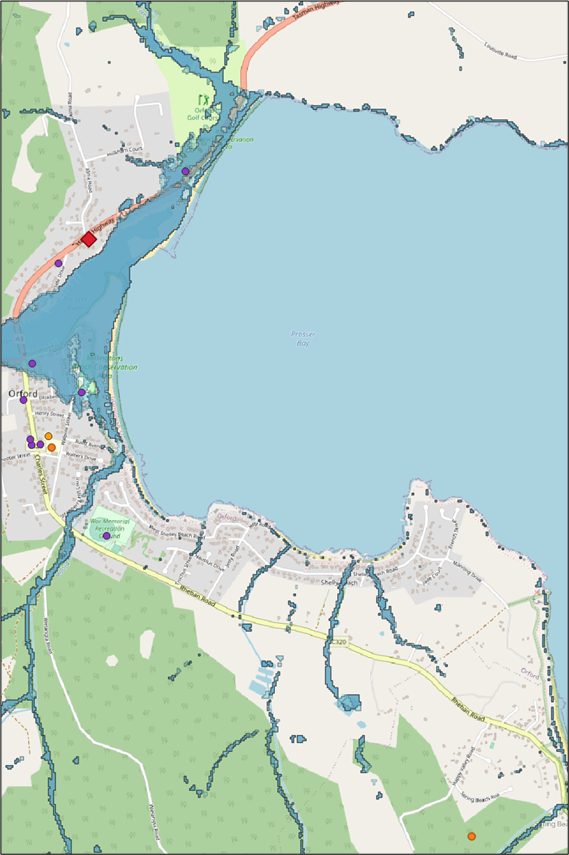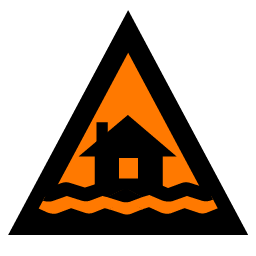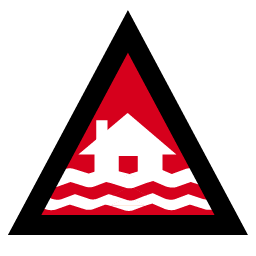Riverine flooding information for the Prosser River and surrounding minor waterways

The Prosser River and surrounding waterways can cause flooding in and around Orford. The map shows where a flood may reach. The darker blue areas are the most likely to flood. There is a 2% chance that such a flooding event like this can happen in a year, with project climate changes increasing this likelihood.
In a major flood, roads in and around Orford will be cut before some areas are flooded. If you need to evacuate, pick up children from school or travel for some other reason, you should do so early, before flood waters rise. Listen to ABC local radio for warnings and advice.
All routes in and out of Orford are likely to be inundated and probably impassable in the major flooding event, including to Triabunna. Backroads may be cut by floodwater, landslips or fallen trees, making it dangerous to drive in isolated areas. There are also some areas around the town that can be prone to storm water run-off.
Riverine flood waters may isolate your home or other property. Even if your property is not flooded, you may not be able to access help if needed. You should have supplies for at least three days and prepare for power and telecommunications outages.
Are you at risk of flood?
Past flooding events around Orford include:
- June 2016 when up to 220mm fell over 72 hours
- June 2009 when extensive East Coast flooding caused a landslide at Paradise Gorge, and other routes in and out of Orford were cut
- August 1970 when up to 120mm fell in 24 hours
- May 1969 when up to 180mm fell in 48 hours.
What should I do?
- Check the map to see whether your home or business could flood.
- Check if you can safely get to your home, work, or school during a flood.
- Prepare a Home Emergency Plan.
- If you will be isolated you may need to evacuate early.
- Assess your home or business and prepare it to minimise possible flood damage.

Floods like the one shown in the map or worse will occur again. No two floods are the same.
If you live in a low-lying area, your house may flood. Even if your home is safe, you may need to detour around flooded areas or your road access may be cut. Never drive into or enter flood waters. Roads and bridges may be washed out or unsafe.
Knowing what to do can save your life and help protect your property. Having a Home Emergency Plan is one of the best ways to prepare. Decide on weather and rainfall triggers for when to act.
Know your risk, get ready, reduce risk where you can, connect with others, stay alert and act safe.
Bureau of Meteorology Forecasts, Warnings, and Observations
The Bureau of Meteorology (the Bureau) issues a Severe Weather Warning and/or Thunderstorm Warning for heavy rainfall that may lead to flash flooding whenever heavy rain is expected in an area. The time between the warning and heavy rain occurring can vary from an hour to 24 hours or sometimes more.
The Bureau may issue a Flood Watch for southern rivers when predicted weather might cause floods over the next couple of days. The Flood Watch may include generalized areas when there is a risk of significant rainfall.
TasWater operate gauges on the Prosser dams which measure river flow, however, these are too close to the township to provide useful warning information.
Rainfall Monitoring and Observations
The Mt Koonya Radar is useful for real-time situation awareness of where heavy rainfall is falling. Radar Rainfall estimates are also available to fill in gaps in areas where there are no rainfall stations.
Rainfall stations at Orford, Triabunna, Buckland, Grindstone north of Triabunna and Nugent may provide useful observations, although rainfall can vary significantly across the area. Tasmania’s East Coast is prone to flash flooding from torrential downpours so there may be little warning.
Riverine flood levels at Orford
While no two flood events are the same, a major flood event around Orford
- May be for example due to heavy rainfall in the river catchment of about
- 51mm in 3 hours
- 74mm in 6 hours
- 110mm in 12 hours.
- 197mm in 48 hours
Rainfall will have more impact if surrounding areas are already wet.
- Is likely to inundate all access routes to/ from Orford, isolating the town
- Isolate parts of the town divided by river crossings
- Inundate low-lying areas of the town around
- The Esplanade, Gore Street, Cross Street and nearby Walpole Street, plus some parts of Murphy Court
- Riverside Drive and surrounds
- the end of Walters Drive and Rudolf Ave
- Cause storm water run-off that may flood other areas of the town, for example.
Moderate flooding in and around Orford
- May mean water starts to enter some homes and other buildings
- There is a risk the Tasman Highway near the golf course is inundated (TBC).
In minor flood events:
- Riverine flood water and storm water run-off may reach some building floor levels and impact low-lying paths, parks and backyards.
- Livestock in potential flood areas should be moved to higher ground.
Know your risk, get ready, reduce risk where you can, connect with others, stay alert and act safe.
Before a flood
1. Know your risk
Flooding often happens in Tasmania and can cause widespread and significant damage. In the past 200 years there have been 78 flood related deaths in Tasmania. This guide is to help you understand flood risk in your area.
2. Prepare your household
Have an emergency plan that covers storms and floods
Thinking about what you would do in a storm or flood means you are more prepared and everyone is safer. Have an emergency plan that everyone in your household understands. There are checklists to help you think through your plan – see the SES website or Red Cross Rediplan.
Check your plan regularly and test it by everyone in the household thinking through a flooding scenario that may affect your household.
Prepare an Emergency Kit
Ready to Go
Battery powered radio and torch, spare batteries
Important information, such as your emergency plan
A list of emergency numbers
Food and water
First aid kit
Rubber or strong leather gloves
Pack when needed
Warm clothes, sturdy shoes or boots
Medicine, glasses or other essential items
Mobile phone and phone charger
Pet food and anything else they need
Photos and special keepsakes
Important documents, for example
– insurance papers
– passports and
– birth certificates
Regularly test batteries in radios and torches.
3. Reduce your risk from flooding where you can
- Think about storms, flooding and other hazards when buying, maintaining or developing property.
- Trim or remove trees and branches overhanging your home, business or near powerlines on your property.
- Keep your gutters and drains clear.
4. Connect with others
Know your neighbours and get involved in your community. A connected community is a safer and more resilient community in an emergency and can help everyone recover better afterwards. Check that family and neighbours are safe and aware of what’s happening.
During
5. Keep up to date
Keep aware of what is happening around you. Check forecasts, observations and warnings regularly.
- TasALERT
- your local ABC radio station or
- the Bureau of Meteorology’s website.
Understand the warnings and key information
 | Advice (Yellow): an incident has started. There is no immediate danger. Stay up to date in case the situation changes. |
 | Watch and Act (Orange): There is a heightened level of threat. Conditions are changing and you need to start taking action now to protect you and your family |
 | Emergency Warning (Red): An Emergency Warning is the highest level of warning. You may be in danger and need to take action immediately. Any delay now puts your life at risk. |
 | Community update (Blue): Specific information and updates for affected communities regarding a particular event or incident. |
| Incident (White): an incident is the initial occurrence of an event before it becomes an emergency warning. As soon as an incident is reported, TasALERT published basic information including the type and location of incident. |
6. Act Safe
- Supervise children.
- Prepare for possible power, water or internet outages.
- Check your emergency kit is ready to go.
- Keep clear of flooded areas such as drains. NEVER walk, play, ride or drive in floodwater. You can’t always see what is under the water or how deep or fast-moving the water is. It is easy to be swept away and drown in as little as 20cm of fast-moving water. Flood water can be dangerous.
When your home may be flooded
- Put household items up high to minimise possible damage.
- Turn off the electricity and gas if it is safe to do so.
- A great way to stop sewerage flowing back into your home is to place sandbags inside plastic bags and use them to block toilets and cover drains and sinks.
- Leave while you can get out safely.
If you need to evacuate
- Follow the advice from SES / Tasmania Police.
- Take your emergency kit.
- Go to friends or family in a safer place or an evacuation centre.
- Let others know where you have gone.
Look after your animals
You are responsible for your animals in an emergency. If you have pets and other animals it will take you longer to evacuate in a flood or other emergency. Move livestock from flood prone areas well before flood waters may rise. For more information see
- RSPCA’s guidance on preparing for animals in an emergency
- Huon Valley Council’s advice on preparing an emergency pet plan
- the Primary producer farm flood readiness toolkit
Avoid travelling during and after storms
- Do not go sightseeing. Sightseers delay emergency services and cause accidents.
- Watch out for hazards such as
- water over roads
- damaged powerlines
- landslides
- damaged roads
- falling trees or roofing iron.
- Never drive through flood waters. Most deaths and rescues in floods are from people driving through flood waters.
- Drive slowly and turn your headlights on roads not affected by flood waters.
After
- Keep listening for ABC Local Radio updates, road re-openings, community meetings, etc.
- If you left your home, do not return home until SES or Tasmania Police tell you it is safe to do so.
- Be aware of road hazards, such as mud or debris on the road, damaged roads/bridges and crews working on clean-up and repairs.
If your home has been damaged
- Stay at ground level while checking for damage. Be careful of fallen trees, broken glass, loose roofing or other hazards.
- Wear strong boots, gloves and protective clothes.
- Use a torch, never use matches or candles inside flood affected buildings.
- Boil all drinking water until you are told the tap water is safe again.
- Do not turn on it is tested by a licensed electrician or gas fitter for safety.
- If your home is damaged and you need to stay somewhere else, take your emergency kit and pets with you
- Take photos of any damage if safe for you to do so and contact your insurance company.
- Supervise children.
- Check neighbours are okay.
For further information go to www.ses.tas.gov.au
Staying informed and further information
Current warnings (TasAlerts) alerts.tas.gov.au
Bureau of Meteorology (BoM) bom.gov.au/tas/warnings
Emergency Broadcasters ABC 936AM
TAS SES Social Media
facebook.com/sestasmania
twitter.com/sestasmania
SES – Preparing for Flood Emergencies
Glamorgan Spring Bay Council phone 03 6256 4777


